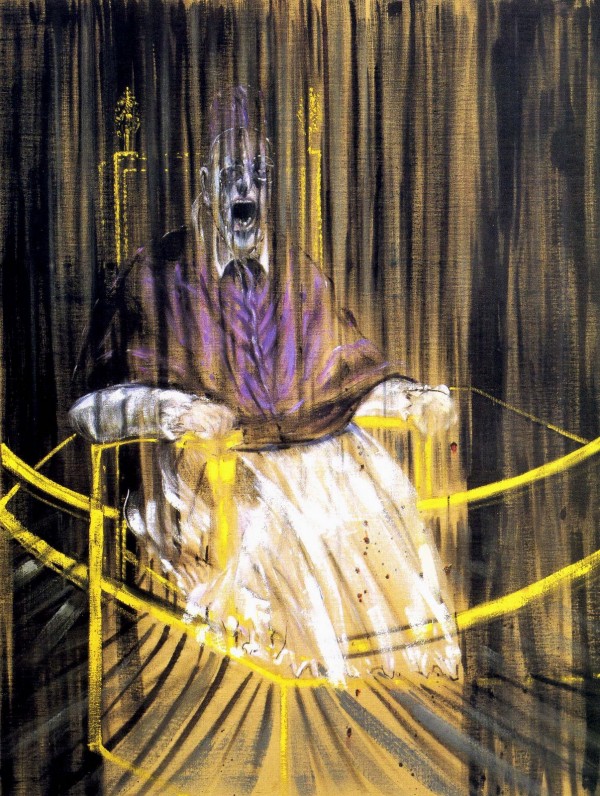“Study after Velázquez’s Portrait of Pope Innocent X” by FRANCIS BACON
DAILY NEWS: ANDY DRUDING has a lot to say to the priest who he says repeatedly raped him when he was a middle-school choir boy. So he wrote the Rev. Francis S. Feret a letter. He wanted to give it to him personally, but hasn’t – still scared, after 40 years, to see Feret again. But Tuesday, Druding read his letter in the most public of venues: a news conference at which it was announced that eight more lawsuits have been filed, including one by Druding, against the Philadelphia Archdiocese, its leaders and seven priests accused of sexually abusing children. A flushed, sweating, trembling Druding took the podium and read, as if addressing Feret, his former choir director at St. Timothy’s Catholic School in Mayfair: “You took advantage of a 9-year-old boy who loved to sing and was afraid to tell because you were a priest, God’s messenger on Earth, the most holy person in my life. But I’ve never forgotten what you did to me. I remember every day of my life, the details so graphic and so horrific. I see your face all the time in my mind, in strangers’ faces, in scary dreams and even in terrible flashbacks that I have to this day.” The eight lawsuits filed Tuesday by attorneys Dan Monahan, Marci Hamilton and Jeffrey Anderson follow eight others the legal trio filed earlier in Common Pleas Court. Altogether, the legal team represents 17 people who say they were sexually abused as children by Philadelphia-area priests. MORE
 RELATED: In 1955 there was a modest retrospective of Francis Bacon‘s paintings at the Institute of Contemporary Arts, followed in 1962 by a far larger retrospective at the Tate Gallery, which was a revelation to me. I still think of Bacon as the greatest painter of the post-war world.’ […] Bacon’s paintings were screams from the abattoir, cries from the execution pits of World War II. His deranged executives and his princes of death in their pontiffs’ robes lacked all pity and remorse. His popes screamed because they knew there was no God. Bacon went even further than the surrealists, assuming our complicity in the mid-century’s horrors. It was we who sat in those claustrophobic rooms, like TV hospitality suites in need of a coat of paint, under a naked light bulb that might signal the arrival of the dead, the only witnesses at our last interview. Yet Bacon kept hope alive at a dark time, and looking at his paintings gave me a surge of confidence. I knew there was a link of some kind with the surrealists, with the dead doctors lying in their wooden chests in the dissecting room, with the film noir and with the peacock and the loaf of bread in Crivelli’s ‘Annunciation’. There were links to Hemingway and Camus and Nathanael West. A jigsaw inside my head was trying to assemble itself, but the picture when it finally emerged would appear in an unexpected place. MORE
RELATED: In 1955 there was a modest retrospective of Francis Bacon‘s paintings at the Institute of Contemporary Arts, followed in 1962 by a far larger retrospective at the Tate Gallery, which was a revelation to me. I still think of Bacon as the greatest painter of the post-war world.’ […] Bacon’s paintings were screams from the abattoir, cries from the execution pits of World War II. His deranged executives and his princes of death in their pontiffs’ robes lacked all pity and remorse. His popes screamed because they knew there was no God. Bacon went even further than the surrealists, assuming our complicity in the mid-century’s horrors. It was we who sat in those claustrophobic rooms, like TV hospitality suites in need of a coat of paint, under a naked light bulb that might signal the arrival of the dead, the only witnesses at our last interview. Yet Bacon kept hope alive at a dark time, and looking at his paintings gave me a surge of confidence. I knew there was a link of some kind with the surrealists, with the dead doctors lying in their wooden chests in the dissecting room, with the film noir and with the peacock and the loaf of bread in Crivelli’s ‘Annunciation’. There were links to Hemingway and Camus and Nathanael West. A jigsaw inside my head was trying to assemble itself, but the picture when it finally emerged would appear in an unexpected place. MORE

